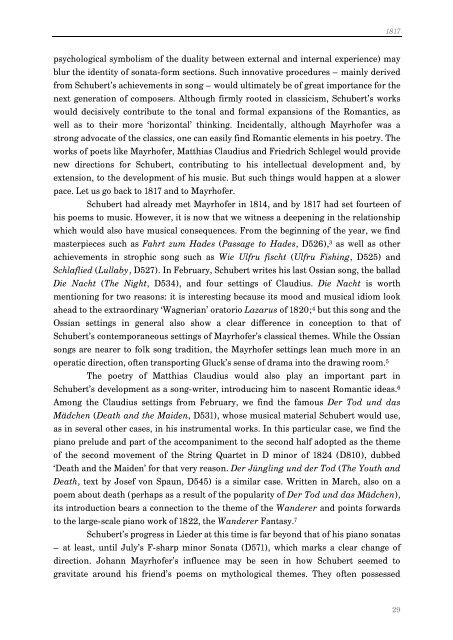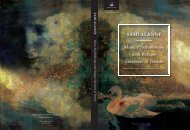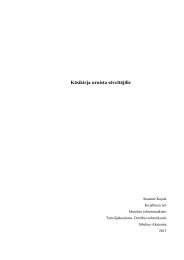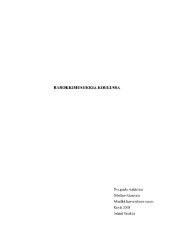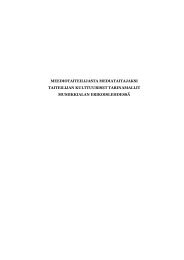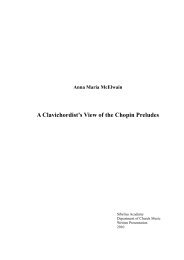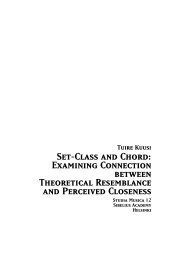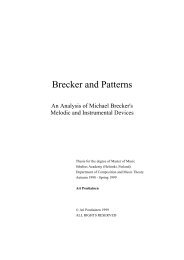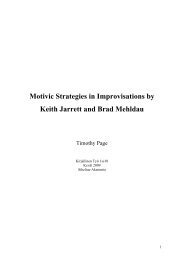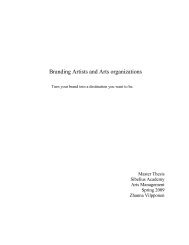The Unfinished Piano Sonatas of Franz Schubert Javier ... - Ethesis
The Unfinished Piano Sonatas of Franz Schubert Javier ... - Ethesis
The Unfinished Piano Sonatas of Franz Schubert Javier ... - Ethesis
You also want an ePaper? Increase the reach of your titles
YUMPU automatically turns print PDFs into web optimized ePapers that Google loves.
psychological symbolism <strong>of</strong> the duality between external and internal experience) may<br />
blur the identity <strong>of</strong> sonata-form sections. Such innovative procedures – mainly derived<br />
1817<br />
from <strong>Schubert</strong>’s achievements in song – would ultimately be <strong>of</strong> great importance for the<br />
next generation <strong>of</strong> composers. Although firmly rooted in classicism, <strong>Schubert</strong>’s works<br />
would decisively contribute to the tonal and formal expansions <strong>of</strong> the Romantics, as<br />
well as to their more ‘horizontal’ thinking. Incidentally, although Mayrh<strong>of</strong>er was a<br />
strong advocate <strong>of</strong> the classics, one can easily find Romantic elements in his poetry. <strong>The</strong><br />
works <strong>of</strong> poets like Mayrh<strong>of</strong>er, Matthias Claudius and Friedrich Schlegel would provide<br />
new directions for <strong>Schubert</strong>, contributing to his intellectual development and, by<br />
extension, to the development <strong>of</strong> his music. But such things would happen at a slower<br />
pace. Let us go back to 1817 and to Mayrh<strong>of</strong>er.<br />
<strong>Schubert</strong> had already met Mayrh<strong>of</strong>er in 1814, and by 1817 had set fourteen <strong>of</strong><br />
his poems to music. However, it is now that we witness a deepening in the relationship<br />
which would also have musical consequences. From the beginning <strong>of</strong> the year, we find<br />
masterpieces such as Fahrt zum Hades (Passage to Hades, D526), 3 as well as other<br />
achievements in strophic song such as Wie Ulfru fischt (Ulfru Fishing, D525) and<br />
Schlaflied (Lullaby, D527). In February, <strong>Schubert</strong> writes his last Ossian song, the ballad<br />
Die Nacht (<strong>The</strong> Night, D534), and four settings <strong>of</strong> Claudius. Die Nacht is worth<br />
mentioning for two reasons: it is interesting because its mood and musical idiom look<br />
ahead to the extraordinary ‘Wagnerian’ oratorio Lazarus <strong>of</strong> 1820; 4 but this song and the<br />
Ossian settings in general also show a clear difference in conception to that <strong>of</strong><br />
<strong>Schubert</strong>’s contemporaneous settings <strong>of</strong> Mayrh<strong>of</strong>er’s classical themes. While the Ossian<br />
songs are nearer to folk song tradition, the Mayrh<strong>of</strong>er settings lean much more in an<br />
operatic direction, <strong>of</strong>ten transporting Gluck’s sense <strong>of</strong> drama into the drawing room. 5<br />
<strong>The</strong> poetry <strong>of</strong> Matthias Claudius would also play an important part in<br />
<strong>Schubert</strong>’s development as a song-writer, introducing him to nascent Romantic ideas. 6<br />
Among the Claudius settings from February, we find the famous Der Tod und das<br />
Mädchen (Death and the Maiden, D531), whose musical material <strong>Schubert</strong> would use,<br />
as in several other cases, in his instrumental works. In this particular case, we find the<br />
piano prelude and part <strong>of</strong> the accompaniment to the second half adopted as the theme<br />
<strong>of</strong> the second movement <strong>of</strong> the String Quartet in D minor <strong>of</strong> 1824 (D810), dubbed<br />
‘Death and the Maiden’ for that very reason. Der Jüngling und der Tod (<strong>The</strong> Youth and<br />
Death, text by Josef von Spaun, D545) is a similar case. Written in March, also on a<br />
poem about death (perhaps as a result <strong>of</strong> the popularity <strong>of</strong> Der Tod und das Mädchen),<br />
its introduction bears a connection to the theme <strong>of</strong> the Wanderer and points forwards<br />
to the large-scale piano work <strong>of</strong> 1822, the Wanderer Fantasy. 7<br />
<strong>Schubert</strong>’s progress in Lieder at this time is far beyond that <strong>of</strong> his piano sonatas<br />
– at least, until July’s F-sharp minor Sonata (D571), which marks a clear change <strong>of</strong><br />
direction. Johann Mayrh<strong>of</strong>er’s influence may be seen in how <strong>Schubert</strong> seemed to<br />
gravitate around his friend’s poems on mythological themes. <strong>The</strong>y <strong>of</strong>ten possessed<br />
29


